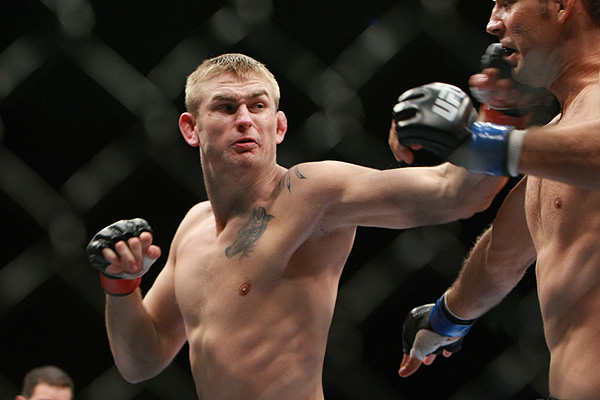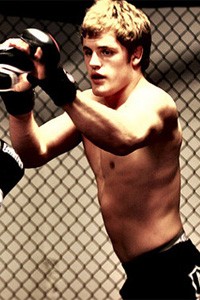Nordic Warming Trend

As the snow melts away, so does some of the long-standing resistance toward MMA. It's hard to identify an exact tipping point, but there is enough happening in Denmark, Finland, Iceland, Norway, and Sweden to know that change is in the Nordic air.
The Cold Reality
While the upcoming UFC on Fuel TV 2 in Sweden may seem like just another stop on the UFC’s international rollout, it’s actually a remarkable turnaround and statement about how far MMA has come in the Nordic region in such a short time period.
Advertisement
On the media side, mainstream exposure of the sport has traditionally fallen into either a “lifestyle” study or a television program like “Debatt” [Debate in English], which puts the combat sport on trial. These programs are set up to discuss and question the controversial combat activity and typically start with some vicious KO -- the clip of choice for last November’s “Debatt” program in Sweden was Vitor Belfort knocking out Yoshihiro Akiyama at UFC 133, leaving him face down and motionless on the ground. Fans and practitioners have become accustomed to defending the sport against brain scientists and those questioning the morality of the activity, with the background of brutal KO’s and blood-ridden battles as the starting point.
“The topic of MMA has been a regular occurrence on TV debate
programs over the last five to six years. I’m sure we’ll see more
in the future, but as a topic it certainly has had plenty of air
time,” says George Sallfeldt, President of the Swedish MMA and a
frequent guest on such programs.
Making it Official
However, the treatment in the media has recently started to take a turn. The change might be best represented by the surprise announcement from the Aftonbladet, a Swedish daily newspaper, last December.
With MMA websites usually responsible for breaking all the latest news and rumors, it came as a surprise that the newspaper ran this headline in its sports section: “The UFC is Coming to Sweden: Event in April.” In an exclusive interview with Dana White, the paper broke the news that the much-rumored debut event was now official.
With the Octagon’s destination as the Ericsson Globe, the same location that the NHL has been using recent season openers, the platform couldn’t be bigger to make a statement that MMA has arrived. The 14,000 available seats inside the venue sold out just three hours after going on sale to the public, making it the fastest-selling UFC event in Europe. Such interest has only increased the magnitude of the event.
“I have people contacting me daily asking for interviews and looking for different types of information about MMA. However, the types of questions we’re getting are changing. It used to be mainly about safety risks within MMA, [but] today the majority of the questions are about the sport, the athletes and the different events taking place,” explains Sallfeldt.
Winning Adds Fuel to the Fire
Alexander Gustafsson is on the cusp of a making a name for himself worldwide as he climbs his way closer to the top of the light heavyweight division. “The Mauler” has amassed a 5-1 record in the UFC and is headlining UFC on Fuel TV 2 card against Thiago Silva.
The Swede joins Danish welterweight standout Martin Kampmann as a Nordic fighter that can top international cards, as both men get closer to a title shot in their respective divisions. While many in the media may not comprehend all the facets of MMA or why anyone would voluntarily step into a cage to fight, it’s easy to report on the accomplishments of a fellow countryman becoming the best in the world.
In addition to the Gustafsson and Kampmann bout, there is also the next generation of fighters performing well against international competition. The recent Cage Warrior’s Fight Night 3 featured five Nordic-trained fighters. All five fighters won on the card, including impressive performances by Sweden native Mats Nilsson, who submitted “Ultimate Fighter 6” veteran Tom Speer, and Finland native Juha-Pekka Vainikainen, who scored a TKO over UFC veteran Kyle Watson. Now, even the wins by local MMA athletes are starting to sneak into the sports sections of local newspapers.
Breaking the Ice

Gunnar
Nelson File Photo
Nelson may be an elite prospect.
In a country where professional boxing is outlawed and there is no organization to sanction any MMA, broadcast TV Station 2 decided to make a bold commitment to the sport and show Nelson’s recent fight from Dublin.
“Just before the live broadcast, they showed a special 30 minutes program on Gunnar and his participation at the 2011 Abu Dhabi Combat Club Submission Wrestling Championship. And every single news site had more than one report or interview about this fight; one of the big news sites probably had around 10-20 both before and after the fight,” says Haraldur “Halli” Nelson, Gunnar’s father and manager.
“There is definitely more interest now than before, and I know that Station 2 is looking into showing UFC live and maybe some other MMA shows. They also told me that because of the ratings they got on Gunnar’s fight against Alexander Butenko they are interested in showing all of Gunnar’s fights live in Iceland,” Haraldur Nelson explains.
Snatching Up the Talent
Another factor in the increased coverage can be attributed to the elevated visibility of more and more Nordic athletes competing at a high level. At the end of last year, the current UFC roster was composed of only four such competitors: Denmark’s Martin Kampmann, Sweden’s Alexander Gustafsson and Papy Abedi and Norway’s John Olav Einemo.
Today, the Nordic roster has expanded to include Norway’s Simeon Thoresen, Finland’s Anton Kuivanen, and Sweden’s Jorgen Kruth, Reza Madadi, Besam Yousef, and Magnus Cedenblad. Akira Corassani will also join the cast once his post-TUF injuries come to an end. Bellator has also jumped on board, signing the young and talented Marcus Vanttinen [Finland] and Mikkel Parlo [Denmark].
The Reality Impact
Reality TV has also played a significant role in promoting MMA. Anton Kuivanen has became a face of the sport with his recent hit reality TV show called “Sali” [The Gym], which allowed Finland to get to know the athlete inside and outside of the cage. The transition to morning talk shows has been seamless for Kuivanen, as he was featured on YLE -- the Finnish BBC -- in a straight-forward sports interview prior his UFC debut this past February.
With professional boxing and MMA outlawed in Norway, a creative reality show on Viasat’s 4 has helped introduce the country to the sport. “Norges Beste Fighter” [Norway’s best fighter] is staged in Thailand and shows athletes from different disciplines training and competing each episode to stay on the island. With the Det Norske MMA Forbundet [The Norwegian MMA Federation] recently established, perhaps next year’s season could be filmed in the country.
The Public Arena
Every weekend, you’ll find some sort of local MMA in the region. “The interest for MMA among the general public is growing fast, both on the spectator side and on the amateur/recreational side,” says Sallfeldt. Royal Arena, which was held on March 10 in Copenhagen, stands above the rest in terms of mainstream exposure.
“I think Royal Arena already has had a massive impact on Danish MMA, as it was shown live on TV, which was a first. The undercard was [also] shown live on a stream on the biggest newspaper website in Denmark,” explains Tue Trnka, a prominent fight commentator for Eurosport and manager/trainer of several top Danish fighters.
“It feels like the sport just went mainstream,” Trnka adds, reflecting on the breakthrough event that has already locked up a four-fight deal with the mainstream TV 2 sport and plans to deliver a steady injection of live MMA to Denmark.
Mikkel Parlo, who headlined the card, was on “GO’ Morgen Danmark” [Good Morning Denmark] in a morning talk show interview about the sport and his bout, showing just how far the media has come in terms of embracing MMA.
Not All Sunshine
While the public and media are becoming more and more receptive to MMA, and the upcoming UFC in Sweden is sure to help bring more awareness to the sport, not all doors are wide open. Pasi Sormunen, co-owner and promoter of the prominent Finnish promotion Cage, had plans for a spring event at the Helsinki Music Center. However, the venue refused to host MMA, with the reflective Sormunen saying, “It’s a sport not everyone likes.”
It is naive to think that MMA would be considered mainstream any time soon, but it can’t be denied that Nordic countries are warming up to MMA. Only time will tell if the trend is seasonal or not.
Related Articles







